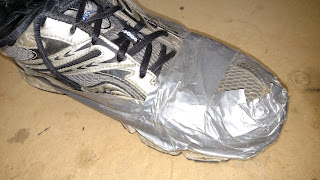What Kind of Christmas Tree is Best?
 |
| Best Christmas Tree? |
There are many Christmas tree options- you can get a "real" Christmas tree, an artificial Christmas tree, and even a living Christmas tree. I have done all of these. Today I will share the pros and cons of each.
Real Christmas Trees
A "real" Christmas tree is a living evergreen tree that is cut. You bring this tree home, place it in a Christmas tree stand with water, and dispose of it after the Christmas season. A real Christmas tree tends to dry out, so you need to make sure to keep water in the stand and dispose of it before it dries out too much. A dry Christmas tree is very flammable, and you don't want something like this in your house.
An advantage of a real Christmas tree is that it smells great. You get a fresh pine smell. Related to this is a downside- you'll have pine needles to sweep up or vacuum up as they fall from the tree.
The logistics of dealing with a real Christmas tree are a drawback. You need to drive to a tree farm or store parking lot where Christmas trees are sold, tie it to the roof of your car, and drive it home. Almost all real Christmas trees are too tall to fit inside a vehicle. When you get the tree home, you need to remove it from the roof of your car, use a saw to cut an inch or so off of the trunk so it will absorb more water, and bring it inside. Next, you set up your Christmas tree stand and work on getting the tree level. The tree often looks fine when you are lying on the floor tightening the bolts that hold it in the tree stand, but then it looks crooked when you step back and look at it. It can take a few tries to get it screwed into the stand level. Next you carefully add water to the stand and go about decorating the tree.
One of the pros of getting a real Christmas tree is that it is fun to go with your family to the Christmas tree lot, pick out a tree, and bring it home. This is much more of a memorable holiday event than hauling the artificial tree box down from the attic.
Cost is a negative for a real Christmas tree. Real Christmas trees cost between $40 to $100 each, depending on the species and size. This cost adds up year after year. We spent hundreds of dollars on real Christmas trees during the years that we went with that option.
Pro: Looks nice, smells nice, can be fun to pick out.
Con: Most expensive Christmas tree option, need to haul it home, drops needles, can be difficult to mount in tree stand, can be fire hazard if it dries out
Artificial Christmas Trees
The next option is getting an artificial Christmas tree. One drawback of artificial Christmas trees is that assembly is required. Some artificial trees have sections or branches that need to be installed in the right places to build the tree. I don't think assembly is a big drawback since you are going to spend a lot of time decorating the tree anyway.
Some artificial Christmas trees come "lighted" with pre-installed Christmas lights which can be a big time saver.
You will also need to have a place to store an artificial tree year round, and you'll need to move your artificial tree every time you move.
Another disadvantage is that cheaper artificial Christmas trees look really fake- they are clearly made with plastic needles and no one is going to think it is a real tree.
An advantage for artificial Christmas trees is that they don't have good sides and bad sides like real trees have. When I used real Christmas trees, we would need to look it over and decide which side should face out. With an artificial Christmas tree it doesn't matter which side you are facing since the symmetry is perfect.
The initial cost of an artificial Christmas tree is typically higher than the same size of real Christmas tree, but since you can use an artificial Christmas tree for many years, this cost is offset in a few years. An artificial Christmas tree is the most cost effective type of Christmas tree.
One reader reported that they bought an artificial Christmas tree over 30 years ago for $6 and are still using it! You can save a lot of money over the years if you keep the same artificial Christmas tree.
Pro: Cheapest Christmas tree option, lasts many years
Con: Takes space to store, can look fake, requires assembly
Live Christmas Trees
One year we decided to try a live Christmas tree. We got a small tree that came in a pot with its roots, and set it on a small table in our living room. The live tree was only about 3 feet high, so we placed presents under the table. We were able to put a few ornaments on this small tree.
An advantage of a live tree is that you can plant it in the spring. If you want trees anyway, this can be a good way to collect evergreen trees to plant.
A downside of using a real tree is that the tree will be small compared to an artificial or cut Christmas tree. I was willing to try a 3 foot tree instead of a 7 foot tree for similar cost. Another consideration is that it can be hard to find live trees for sale- few stores offer living Christmas trees for sale.
Pro: Get a real tree without cutting one down, get a live tree to plant in your yard
Con: Hard to find for sale, you'll get a much smaller tree for the money
What Kind of Christmas Tree is Best?
- If cost is an important factor for you, get an artificial Christmas tree and use it for many years. The cost per year is clearly least for an artificial Christmas tree.
- If you want to plant trees in your yard and can accept a smaller tree, try a live tree. I liked the idea of not cutting down a tree for Christmas.
- If you enjoy the experience of picking out and bringing home a Christmas tree, then go with a real Christmas tree. The cost for the tree is more, but you are getting more than the tree- you are getting the experience and memories as well.
Copyright © 2015 by Dr. Penny Pincher. All Rights Reserved. Privacy Policy


















